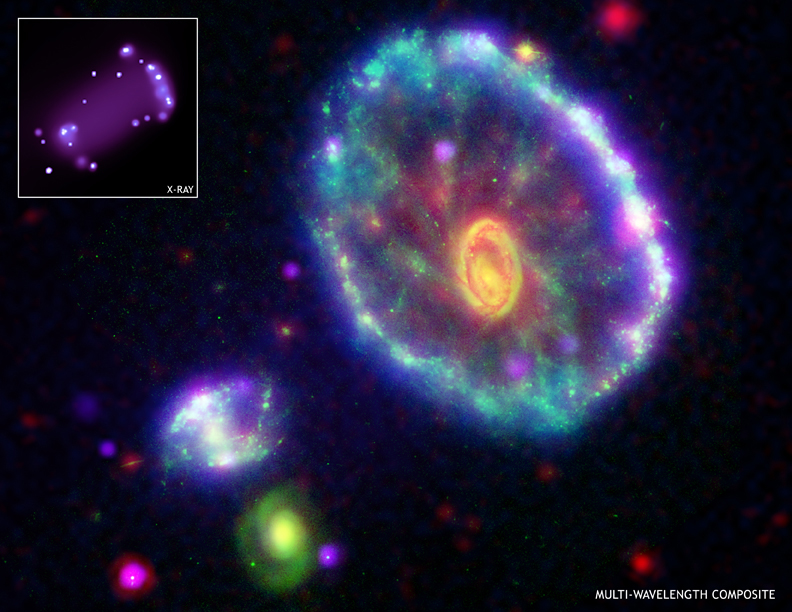
 Credit: Composite: NASA/JPL/Caltech/P.Appleton et al. X-ray: NASA/CXC/A.Wolter & G.Trinchieri et al.
Credit: Composite: NASA/JPL/Caltech/P.Appleton et al. X-ray: NASA/CXC/A.Wolter & G.Trinchieri et al.
Ripples
Galaxy shapes are often a product of the neighborhood in which they live. Take the case of the Cartwheel Galaxy, shown above. The Cartwheel's unsual morphology it thought to have been produced by the passage through it of a smaller galaxy (probably one of the two seen in the lower left of the image above) about 100 million years ago. This collision generated waves traveling out from the site of the splash like ripples in a pool of water. These ripples compressed gas in the galaxy into narrow rings, triggering star formation within the rings. The image of the Cartwheel shown above is a composite of images taken with X-ray, ultraviolet, infrared and optical cameras. The different colors represent the different wavebands: blue shows ultraviolet radiation imaged by the Galaxy Evolution Explorer's Far Ultraviolet detector; a visible light image from the Hubble Space Telescope's Wide Field and Planetary Camera-2 is shown in green; infrared emission seen by the Spitzer Space Telescope's Infrared Array Camera (IRAC) can be seen in red; and X-ray emission measured by the Chandra X-ray Observatory's Advanced CCD Imaging Spectrometer-S array is shown in purple (and shown by itself in the inset image). The different emissions arise from different physical processes. Hot blue stars that formed out of the compressed gas shine brightly in the ultraviolet, while the black holes left over from the explosion of the most massive of these stars shine brightly in X-rays, heated dust throughout the galaxy glows in the infrared, while stars shine brightly in the optical.
Published: March 9, 2015
<
HEA Dictionary ● Archive
● Search HEAPOW
● Other Languages
● HEAPOW on Facebook
● Download all Images
● Education ● HEAD
>

Each week the HEASARC
brings you new, exciting and beautiful images from X-ray and Gamma ray
astronomy. Check back each week and be sure to check out the HEAPOW archive!
Page Author: Dr. Michael F. Corcoran
Last modified Tuesday, 27-Feb-2024 10:06:36 EST


